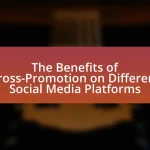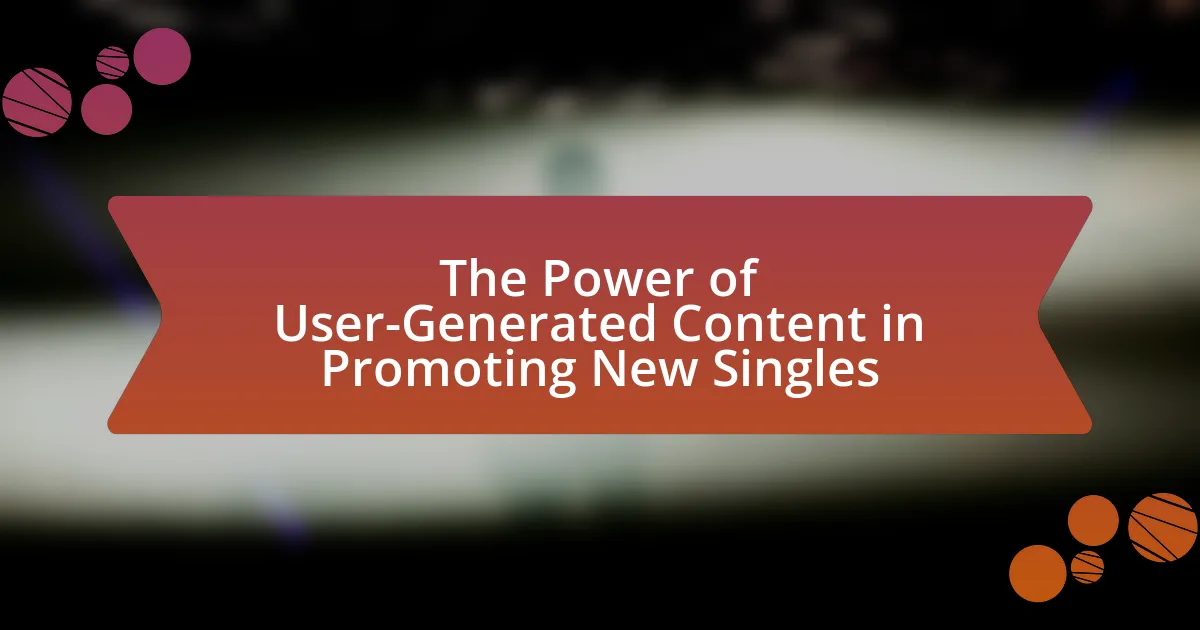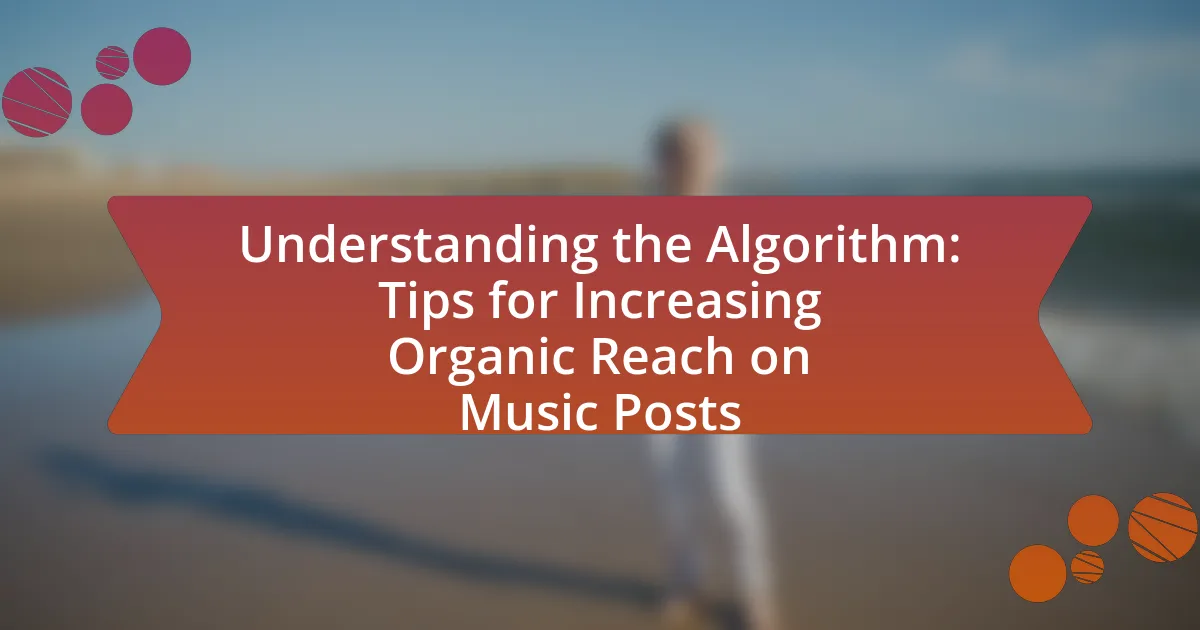The article focuses on leveraging TikTok trends for music promotion, highlighting how popular challenges, dances, and themes can enhance visibility and engagement for artists. It explains the emergence and evolution of TikTok trends, the factors contributing to their virality, and strategies for artists to identify and participate in these trends. Additionally, the article discusses the effectiveness of TikTok as a promotional platform, the demographics of its user base, and best practices for creating engaging content. It also addresses common pitfalls artists should avoid and offers practical tips for maintaining a consistent presence and engaging with their audience effectively.
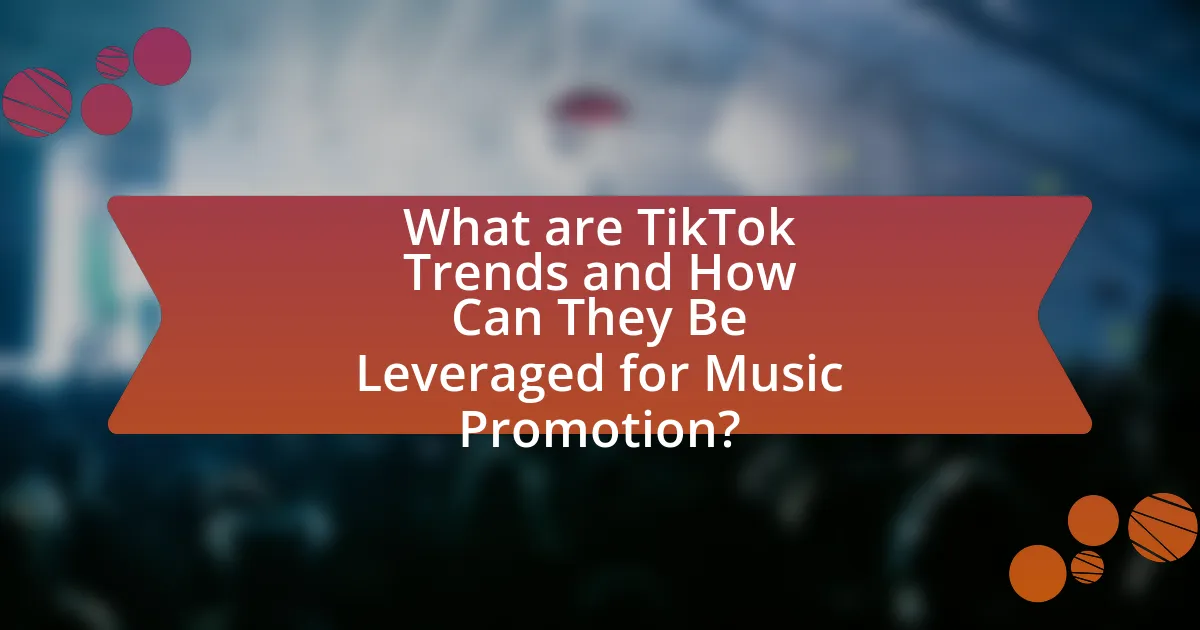
What are TikTok Trends and How Can They Be Leveraged for Music Promotion?
TikTok trends are popular challenges, dances, or themes that gain traction on the platform, often driven by user-generated content. These trends can be leveraged for music promotion by encouraging artists to create content that aligns with trending sounds or challenges, thereby increasing visibility and engagement. For instance, songs that become associated with viral challenges can experience significant boosts in streams and downloads; a notable example is the song “Savage Love” by Jawsh 685 and Jason Derulo, which gained immense popularity after being featured in a TikTok dance challenge, leading to it topping charts globally. By participating in or creating content around these trends, musicians can tap into the platform’s vast audience, enhancing their reach and potential for viral success.
How do TikTok trends emerge and evolve?
TikTok trends emerge and evolve through user-generated content that resonates with audiences, often sparked by viral challenges, popular songs, or memes. Initially, a trend may begin with a single video that captures attention, leading to widespread participation as users replicate or adapt the original concept. The platform’s algorithm amplifies these trends by promoting engaging content, which encourages further creativity and variation. For example, the “Renegade” dance trend started with a specific choreography that went viral, inspiring countless remixes and adaptations, showcasing how trends can evolve through user interaction and creativity.
What factors contribute to the virality of TikTok trends?
The factors that contribute to the virality of TikTok trends include user engagement, algorithmic amplification, and cultural relevance. User engagement is driven by the platform’s interactive features, such as challenges and duets, which encourage participation and sharing. The TikTok algorithm prioritizes content that garners high engagement rates, promoting videos that resonate with users, thus amplifying their reach. Additionally, trends often align with current cultural moments or popular music, making them more relatable and shareable. For instance, a study by the University of Southern California found that trends linked to popular songs or memes have a higher likelihood of going viral due to their connection to existing cultural narratives.
How can artists identify trending sounds and challenges?
Artists can identify trending sounds and challenges by actively monitoring TikTok’s Discover page and utilizing analytics tools that track popular audio clips. The Discover page showcases the most viral content, allowing artists to see which sounds are currently gaining traction. Additionally, platforms like TikTok Analytics provide insights into trending hashtags and sounds, helping artists understand what resonates with users. According to a report by Hootsuite, over 60% of TikTok users discover new music through the app, highlighting the importance of staying updated on trends for effective music promotion.
Why is TikTok an effective platform for music promotion?
TikTok is an effective platform for music promotion due to its vast user engagement and viral content potential. The platform boasts over 1 billion active users, with a significant portion of them actively participating in trends and challenges that often feature music. This high level of interaction allows songs to gain rapid exposure, as users create and share videos that incorporate specific tracks, leading to increased streams and downloads. Additionally, TikTok’s algorithm promotes content based on user preferences rather than follower count, enabling even lesser-known artists to reach a wide audience quickly. This unique combination of user engagement and algorithmic support makes TikTok a powerful tool for music promotion.
What demographic is most active on TikTok?
The demographic most active on TikTok is primarily Gen Z, specifically individuals aged 16 to 24. This age group represents a significant portion of the platform’s user base, with studies indicating that around 60% of TikTok users fall within this age range. Additionally, according to a report by Statista, as of 2023, approximately 37% of TikTok users are aged 10 to 19, further emphasizing the platform’s appeal to younger audiences.
How does TikTok’s algorithm favor music-related content?
TikTok’s algorithm favors music-related content by prioritizing videos that incorporate trending sounds and songs, which enhances user engagement. The algorithm analyzes user interactions, such as likes, shares, and comments, to identify popular music tracks and promote videos that utilize these sounds. For instance, when a song goes viral, TikTok boosts content featuring that track, leading to increased visibility for creators who use it. This mechanism not only amplifies the reach of music-related content but also encourages artists to collaborate with influencers, further driving the popularity of their music on the platform.
What strategies can artists use to leverage TikTok trends?
Artists can leverage TikTok trends by creating content that aligns with popular challenges, sounds, or hashtags. By participating in trending challenges, artists can increase their visibility and engage with a wider audience, as TikTok’s algorithm favors content that resonates with current trends. For instance, using trending sounds in their videos can lead to higher engagement rates, as users are more likely to interact with familiar audio. Additionally, collaborating with influencers who are already popular on the platform can amplify an artist’s reach, as these influencers can introduce the artist’s music to their established follower base. Data shows that videos featuring trending sounds can receive up to 50% more views than those that do not. Therefore, by strategically aligning their content with TikTok trends, artists can effectively promote their music and grow their fanbase.
How can artists create engaging content that aligns with trends?
Artists can create engaging content that aligns with trends by actively monitoring popular TikTok challenges, sounds, and hashtags relevant to their genre. By participating in these trends, artists can increase their visibility and connect with a broader audience. For instance, a study by the marketing firm Conviva found that videos featuring trending sounds receive 30% more engagement than those that do not. Additionally, artists should tailor their content to reflect their unique style while incorporating elements of these trends, ensuring authenticity and relatability. This approach not only enhances engagement but also fosters a community around their music, as seen with artists like Lil Nas X, who successfully utilized TikTok trends to promote his music and gain widespread recognition.
What role do influencers play in promoting music on TikTok?
Influencers play a crucial role in promoting music on TikTok by leveraging their large followings to create viral content that features specific songs. Their ability to engage audiences through creative challenges, dance routines, or lip-syncing videos significantly increases a song’s visibility and popularity. For instance, songs like “Savage Love” by Jawsh 685 and Jason Derulo gained immense traction on TikTok due to influencers incorporating them into their content, leading to chart-topping success. This phenomenon demonstrates that influencers can effectively drive music trends and contribute to a song’s commercial success by tapping into TikTok’s algorithm, which favors engaging and shareable content.
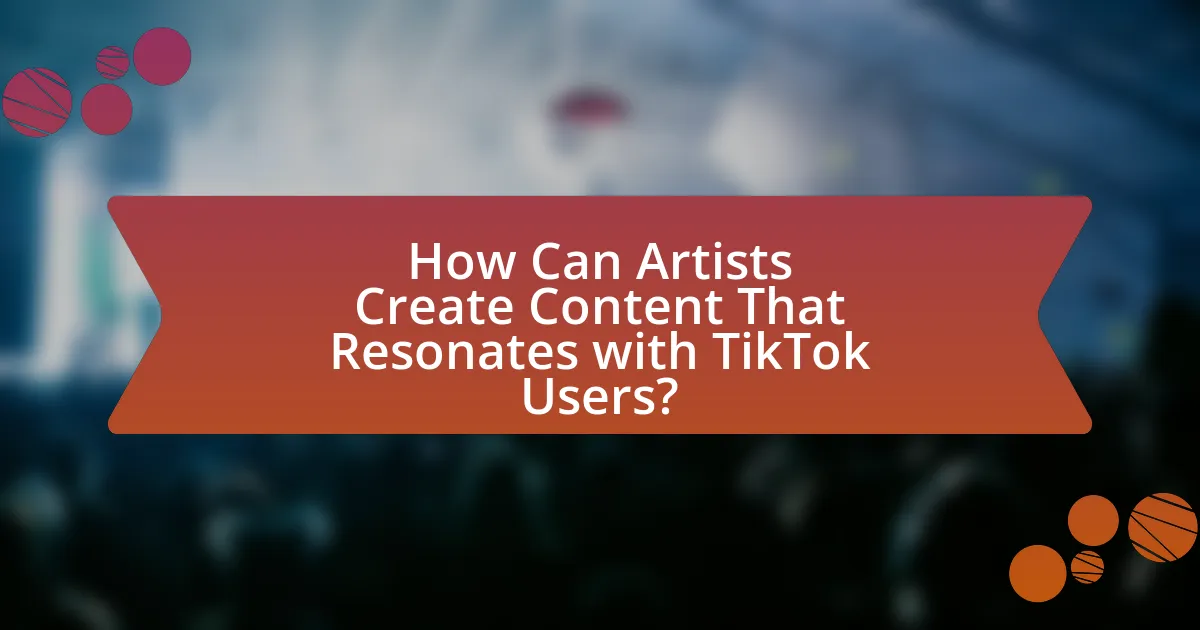
How Can Artists Create Content That Resonates with TikTok Users?
Artists can create content that resonates with TikTok users by aligning their music and visuals with current trends and user preferences. Engaging with popular challenges, utilizing trending sounds, and incorporating relatable themes can significantly enhance visibility and connection with the audience. For instance, a study by the marketing agency HubSpot found that 63% of TikTok users enjoy content that reflects current trends, indicating that timely and relevant content is more likely to engage viewers. Additionally, artists should focus on authenticity and storytelling, as TikTok users appreciate genuine expressions and narratives, which can lead to higher engagement rates.
What types of content are most successful on TikTok for music promotion?
Engaging short videos featuring catchy hooks, dance challenges, and user-generated content are the most successful types of content on TikTok for music promotion. These formats capitalize on TikTok’s algorithm, which favors content that encourages interaction and shares. For instance, songs that become associated with viral dance challenges often see significant increases in streams and downloads, as evidenced by the success of tracks like “Savage Love” by Jawsh 685 and Jason Derulo, which gained popularity through a viral dance trend. Additionally, leveraging trending hashtags and collaborating with influencers can amplify reach and engagement, further validating the effectiveness of these content types in promoting music on the platform.
How can artists utilize challenges and duets effectively?
Artists can utilize challenges and duets effectively by creating engaging content that encourages audience participation and collaboration. By initiating a challenge, artists can motivate fans to create their own videos using their music, which increases visibility and engagement. For instance, popular TikTok challenges often go viral, leading to a significant boost in streams and followers. Additionally, participating in duets allows artists to connect with other creators, expanding their reach and introducing their music to new audiences. This strategy has been validated by the success of numerous artists who gained popularity through viral challenges and collaborative duets on platforms like TikTok, demonstrating the effectiveness of these methods in music promotion.
What are the best practices for using hashtags on TikTok?
The best practices for using hashtags on TikTok include using a mix of trending, niche, and branded hashtags to maximize reach and engagement. Trending hashtags help content gain visibility by tapping into current conversations, while niche hashtags target specific audiences interested in particular themes or genres. Branded hashtags create a unique identity for campaigns and encourage user-generated content. Research indicates that posts with at least one hashtag receive 12.6% more engagement than those without, highlighting the importance of strategic hashtag use. Additionally, limiting hashtags to 3-5 per post is recommended to avoid overwhelming viewers and maintain focus.
How can artists measure the success of their TikTok campaigns?
Artists can measure the success of their TikTok campaigns by analyzing key performance indicators (KPIs) such as engagement rates, follower growth, and video views. Engagement rates, which include likes, comments, and shares, indicate how well the content resonates with the audience; a higher engagement rate suggests a successful campaign. Follower growth reflects the campaign’s ability to attract new fans, while video views provide insight into the reach and visibility of the content. According to a study by Hootsuite, videos that achieve over 1,000 views typically indicate a successful campaign, as they demonstrate effective audience engagement and content virality.
What metrics should artists track to evaluate engagement?
Artists should track metrics such as likes, shares, comments, follower growth, and video completion rates to evaluate engagement. Likes indicate immediate appreciation, while shares reflect how often content resonates with audiences, prompting them to share it with others. Comments provide qualitative feedback and insights into audience sentiment. Follower growth shows the effectiveness of engagement strategies over time, and video completion rates reveal how well content retains viewer attention. According to a study by Hootsuite, posts with higher engagement rates lead to increased visibility on platforms like TikTok, reinforcing the importance of these metrics in assessing overall engagement.
How can feedback from TikTok users inform future content creation?
Feedback from TikTok users can significantly inform future content creation by providing insights into audience preferences and engagement patterns. Analyzing comments, likes, shares, and trends allows creators to identify what resonates with viewers, enabling them to tailor their content accordingly. For instance, a study by the Pew Research Center found that 60% of TikTok users engage with content that reflects their interests, indicating that user feedback directly influences content relevance and appeal. By leveraging this feedback, creators can enhance their strategies, ensuring that future content aligns with user expectations and maximizes engagement.
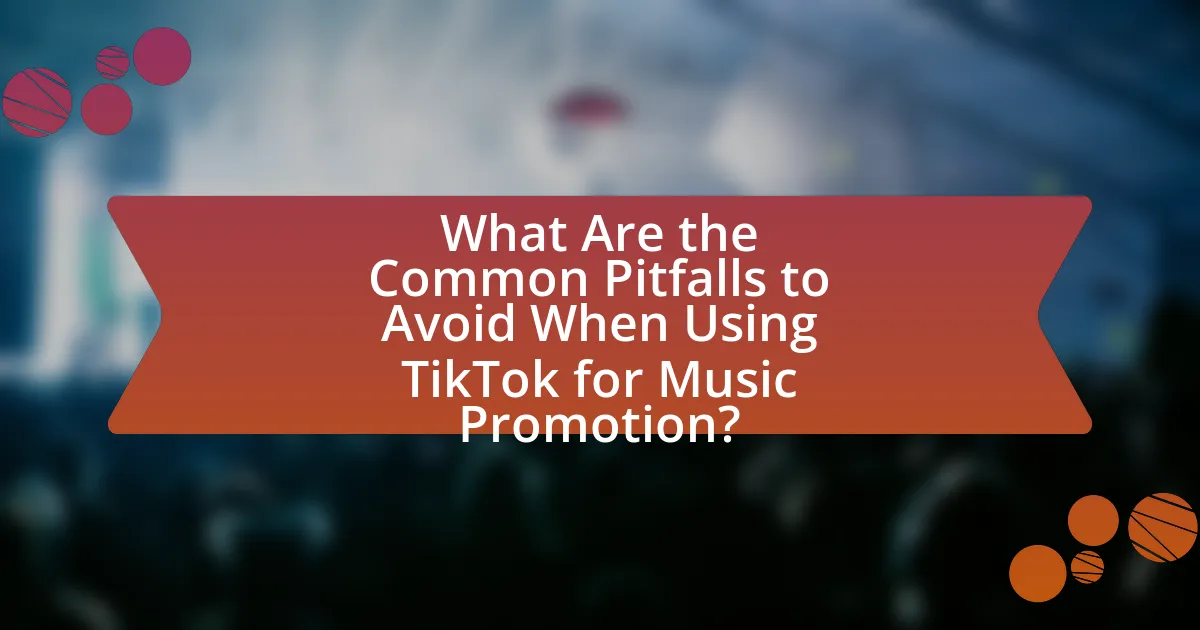
What Are the Common Pitfalls to Avoid When Using TikTok for Music Promotion?
Common pitfalls to avoid when using TikTok for music promotion include neglecting audience engagement, failing to adapt content to the platform’s style, and ignoring analytics. Audience engagement is crucial; brands that do not interact with users miss opportunities to build a loyal fan base. Content must align with TikTok’s informal and creative nature; promotional material that feels overly commercial often fails to resonate. Additionally, ignoring analytics can lead to missed insights on what works; TikTok provides data on video performance that can guide future strategies. These pitfalls can hinder effective music promotion on the platform.
What mistakes do artists often make on TikTok?
Artists often make the mistake of not engaging with their audience on TikTok. This lack of interaction can lead to missed opportunities for building a loyal fan base, as TikTok thrives on community and connection. Additionally, artists frequently fail to utilize trending sounds and hashtags effectively, which can limit their visibility; according to TikTok’s algorithm, content that aligns with current trends is more likely to be promoted. Another common error is posting content that is overly polished or promotional, as TikTok users typically prefer authentic and relatable content over traditional marketing approaches.
How can artists avoid being perceived as inauthentic?
Artists can avoid being perceived as inauthentic by staying true to their unique voice and values while engaging with trends. Authenticity stems from genuine expression; when artists incorporate TikTok trends, they should ensure that these trends align with their artistic identity and message. For instance, artists like Lil Nas X successfully blended personal storytelling with viral challenges, maintaining authenticity while gaining popularity. This approach demonstrates that artists can participate in trends without compromising their core identity, thus fostering a genuine connection with their audience.
What are the risks of over-promoting music on the platform?
Over-promoting music on the platform can lead to audience fatigue, resulting in decreased engagement and interest. When users are inundated with excessive promotional content, they may become desensitized, leading to a negative perception of the artist or song. Research indicates that 70% of users prefer authentic content over overt marketing, suggesting that over-promotion can alienate potential fans. Additionally, algorithms may penalize content that is perceived as spammy, reducing the visibility of the music in users’ feeds. This creates a cycle where the intended promotional efforts backfire, ultimately harming the artist’s reach and reputation.
What are the best practices for maintaining a consistent presence on TikTok?
To maintain a consistent presence on TikTok, creators should post regularly, ideally several times a week, to keep their audience engaged. Regular posting helps to build a loyal following and increases visibility on the platform, as TikTok’s algorithm favors active accounts. Additionally, creators should engage with their audience through comments and direct messages, fostering a community around their content. Utilizing trending sounds and hashtags relevant to music can also enhance discoverability, as TikTok users often search for popular trends. According to a study by Hootsuite, accounts that post consistently see a 50% increase in engagement compared to those that post sporadically.
How often should artists post to maximize visibility?
Artists should post at least once a day on TikTok to maximize visibility. Frequent posting increases engagement and helps artists stay relevant in the fast-paced environment of social media. Research indicates that accounts that post daily can see a significant increase in follower growth and interaction rates, as TikTok’s algorithm favors active users. Additionally, a study by Hootsuite found that brands that post consistently experience 67% more engagement than those that post less frequently. This consistent presence allows artists to tap into trending content and maintain audience interest, ultimately enhancing their promotional efforts.
What strategies can artists use to engage with their audience regularly?
Artists can engage with their audience regularly by creating consistent, relatable content that resonates with their followers. This can include sharing behind-the-scenes footage, participating in trending challenges, and utilizing popular sounds or hashtags on TikTok to increase visibility. Regular interaction through comments, live sessions, and Q&A formats fosters a sense of community and connection. According to a study by Hootsuite, brands that engage with their audience on social media see a 20-40% increase in customer loyalty, highlighting the effectiveness of these strategies in maintaining audience interest and engagement.
What practical tips can artists implement to enhance their TikTok music promotion efforts?
Artists can enhance their TikTok music promotion efforts by creating engaging, trend-based content that resonates with their target audience. Utilizing popular challenges and hashtags can significantly increase visibility; for instance, songs that become associated with viral challenges often see a spike in streams and downloads. Collaborating with influencers who align with their brand can also amplify reach, as influencers have established trust with their followers. Additionally, artists should post consistently and at optimal times to maximize engagement, as TikTok’s algorithm favors active accounts. Engaging directly with fans through comments and live sessions fosters community and loyalty, which can lead to organic promotion. According to a report by TikTok, 67% of users feel more connected to a brand when they engage with it on the platform, highlighting the importance of interaction in promotion strategies.

